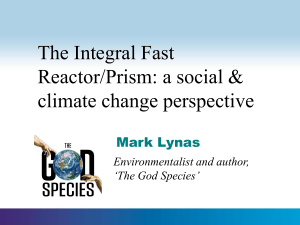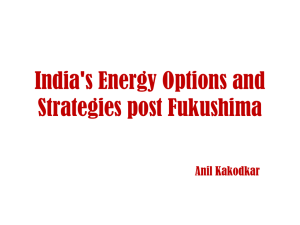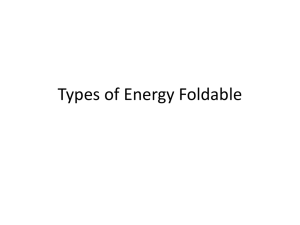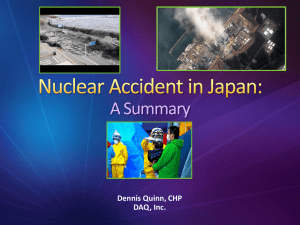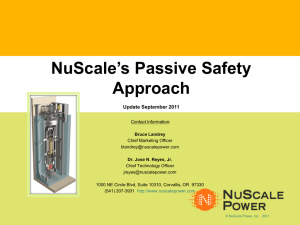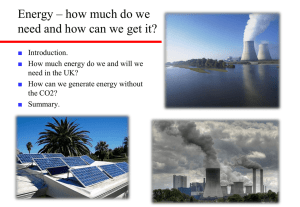Bracchium file
advertisement
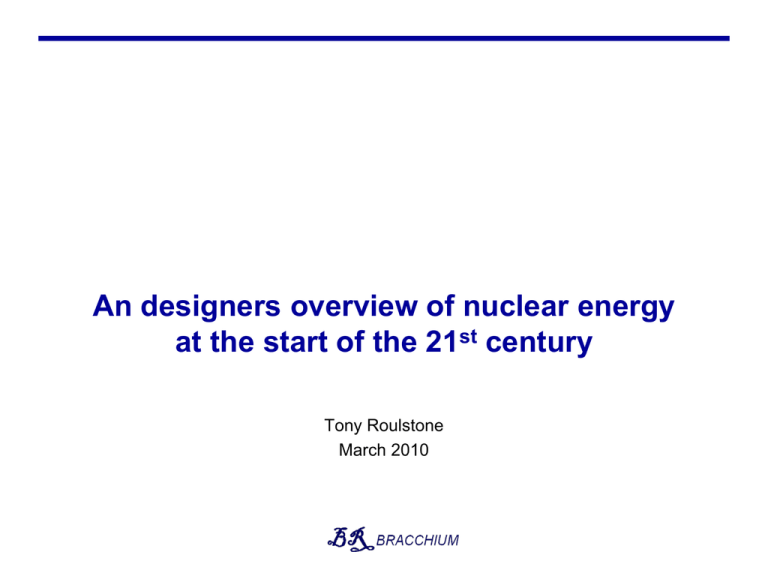
An designers overview of nuclear energy at the start of the 21st century Tony Roulstone March 2010 Summary • After 25 years of retrenchment, nuclear power is firmly on the agenda, both in UK and around the world – driven by the issues of: – – Climate Change; Energy Security. • • UK will replace (at least twice over) the current ~10GWe nuclear capacity; Global potential for >1000 new large reactors in next 30 years – replacing the current 400 reactors (~350 GWe) growing the share of global electricity from 15% to ~35% • Design topics covered: 1. 2. 3. 4. Part 1 Thermal nuclear reactors design essentials; Some design safety & reactor vessel considerations; Extending the fuel resource available for nuclear fission power in thermal systems; Longer term development of Advanced Systems; Part 2 Reactor Design Part 1 Design Safety Fuel Resource Part 2 Advanced Systems Issues for the 21st century? • • • • Response to World Credit Crunch; Climate Change; Nuclear Proliferation; International terrorism. Gordon Brown Mansion House Nov 2009 Nuclear is (for a good or ill) linked to at least 3 of these issues: 1. Credit crunch –> UK over reliance on financial services – new manufacturing? 2. Climate Change -> Expanding and de-carbonising electricity supply; 3. Nuclear Proliferation -> New fuel cycles that avoid creating or protect potential nuclear bomb materials. Civil Nuclear Power Global Market Current capacity: • Nuclear energy currently provides approximately 15% of the world’s electricity. • Currently around 440 nuclear plants, across 30 countries, with a total capacity of over 370 GW. Future Capacity: • There may be a global build rate of up to 12 nuclear reactors per year between 2007-2030, which expected to rise to 23-54 reactors a year between 2030-2050. Market value: • A recent assessment by Rolls-Royce estimated that: • Global civil nuclear market is currently worth around £30bn a year; • By 2023 market could be worth around £50bn per year; • Of this, approximately £20bn pa will be new build, £13bn pa in support to existing nuclear plant, and £17bn pa in support of new build reactors. The Road to 2010 Cabinet Office July 2009 Westinghouse AP1000 Part 1 – Current Reactors Some Reactor Design Considerations Reactor Design 5 Simplified Reactor Physics - Fission Thermal reactor fission: Uranium 235 is the only naturally occurring fissile atom - typical fission reaction n + U235 thermal Xe140 + Sr94 + ~2n + 193Mev fast Fission Product distribution High thermal n absorption low fast n absorption Intermediate energy resonances linked to quantum states - loss of n Uranium 235 fission cross section 6 Simplified Reactor Physics – Criticality (4 factor equation) In an infinite homogenous reactor : 1. Fission of Uranium produces more neutrons than are absorbed by fuel as thermal neutrons – η & 200 MeV of energy 2. Fission neutrons augmented by some fast fission - ε 3. As neutron slowed down, some are lost to process by capture in fuel resonance (1 - p) & others by moderator absorption (1 - f); 4. Surviving thermal neutrons lead to new fission – less than 1 sub-critical, more than 1 supercritical. Infinite multiplication factor Fast neutron energies 1 MeV Intermediate energies Thermal neutrons energies ~0.1eV k∞ = ε * η * p * f η = #fission/#absorbed All these are factor are functions of cross-sections - hence the probabilities are all functions of neutron energy ε* η where ε = fast fission multiplier ε * η * (1 – p) p - resonance capture in fuel ε* η*p*f ε* η *p ε* η * p (1-f) f - moderator absorption 7 The First Nuclear Reactor • • • • • • Enrico Fermi and a team from Metallurgy Department of University of Chicago built and controlled the first sustained nuclear reaction; In a racquets court in Staggs Field athletics stadium of the University of Chicago on 2 Dec 1942; Reactor constructed from Graphite blocks and Uranium metal constructed in ‘pile’ in 30’ * 60’ room with Cadmium coated control rods; The team proved that sustained fission or a multiplication factor k >1 could be achieved , and the measurements were made for the first practical sustained nuclear reactor; Three types of control rods: – Electric motor operated controlling rods; – Emergency ‘zip’ rod driven in by gravity; – Liquid Cadium salts to be released into a control tube. Sustained fission demonstrated by neutron count growing exponentially i.e. keff >1 CP1 – Chicago Pile 1 8 Simplified Reactor Physics – Designs Thermal reactor fission: Infinite multiplication factor k∞ = ε * η * p * f (homogenous infinite reactor) • Most (80%) of the 193 MeV (3.1 * 10-11 J/fission) of energy is released in the fission products as kinetic energy –dissipated within a few microns as heat - fission products interacting with the surrounding material; • 8% as beta and gamma radiation from the decay of fission products – decaying to more stable isotopes; • Other energy in neutrons, prompt gamma rays and neutrinos. Practical systems: - different effects of: enrichment, neutron leakage/reflection, moderator/fuel volume ratio, structural materials, control elements, burnable poisons & re-fuelling strategy etc. Fast fission Fissions per absorption Fuel resonance capture Moderator capture ε ηT 1-p 1-f Infinite multiplication k∞ Thermal diffusion length Core Power rating Enrichment PWR (light water - H20) 1.27 1.89 0.37 0.06 1.41 2.8 cm 100MW/m3 4.2% CANDU (heavy water - D20) 1.0 1.31 0.16 0.03 1.12 1.7m 8MW/m3 0.7% (natural U) 9 Light Water Reactors are Dominant Pressurised Water & Boiling Water Reactors PWR • Derived from submarine propulsion reactors & widely installed around the world ~ half of world capacity; • Low thermal efficiency ~33%; • Major problem was Three Mile Island in 1981 where minor fault led to confusing signals & operators damaged reactor; • Initial materials problems led to low reliability - since rectified • Now preferred in EU, Russia & China, sharing market in US with BWR BWR • Simpler plant with integrated core cooling and power cycle, high radiation dose from operation; • Core and steam separation integrated in one vessel; • Activated Nitrogen16 limits access to turbine during operation; • Some doubts about safety containment; • More complex coolant chemistry; • Popular in US, Sweden and Japan. 10 Pressurised Water Reactor PWR overview: • Operating conditions : • Pressure: 16 MPa • Average temperature: 280-290oC • Reactor core consist of bundles of enriched ~3% Uranium Oxide or (MoX) in open bundles with Zircalloy fuel clad tubes; • Vertical control rods operated from the top of the reactors; • Multiple loops (3 or 4) carrying sub-cooled water, flowing upwards through core; • Refuelling at 3 years intervals from top of core by means of removable vessel head; • Complex coolant injection and decay heat removal systems – issue addressed by latest Westinghouse design AP1000; • Able to separate chemistry strategies of primary and secondary/condenser water; • Most popular reactor design ~50% of installed capacity: US, France, Germany, Spain & now Russia & China – high availability, long fuel cycles & low operator dose. . Boiling Water Reactor BWR overview • Operating conditions: • Pressure (saturated) ~7.3 MPa • Average temperature 310oC • Reactor core consist of bundles of enriched ~3% Uranium Oxide or (MoX) in shrouded bundles with Zircalloy fuel clad tubes; • Vertical control rods operated from bottom of core – do not drop into core to shut-down reactor; • Reactor cooling flow by augmented natural convection; • Steam separators above the core with direct feed to wet steam turbines – some carry over of contamination; • Complex power control and multi-level emergency core cooling systems; • Refuelling at 2 year intervals from top of core by means of removable vessel head; • Coolant chemistry has to cover contamination from condenser water as well as core requirements – not preferred for coast sites because of potential chloride contamination? • Defence against major accident must take account of reactor & turbine building – containment, aircraft crash etc. 12 CANDU Heavy Water Reactor • Canadian design - using natural uranium metal and pressurised heavy water in horizontal Zircalloy pressure tubes, surrounded by heavy water moderator/reflector Core & Moderator tank tank; • Operating Conditions: Temp: 280oC Press: 10MPa • Large dimension core with low power density 8MW/m2; • Conventional wet steam secondary power cycle with low thermal efficiency – 33%; • Regular on-load refuelling using built-in horizontal charge machine; • Complex D2O handling & Tritium is produced & emitted; • Large evolutionary program in Canada with exports based on good operating performance in 1980s : China, Korea, Romania, Argentina, India and Pakistan etc. • More recently, beset with Zircalloy pressure tube delayed hydrogen cracking problems, requiring wholesale replacement of pressure tubes; Candu 6 -Fuel subassemblies 13 Some Design & Safety Considerations Design Safety 14 Nuclear Safety Philosophy Developed world safety approach: • Design base events which are always protected with a significant margin of safety; • Large scale events rendered very unlikely by: o providing defence in depth/multiple barriers to release; o including features and best practise in the design to extent that is ALARP. Frequency pa Complete Protection with high degree of certainty 10-4 Chernobyl ~2 days after the prompt criticality followed by a core fire in 1986 Fundamental faults – design: positive void coefficient & control rod design - plus ,very poor operating knowledge & controls. Larger releases - by design made most unlikely Area of acceptance of design 10-7 ALARP – best practice continually challenged Probabilistic safety target Release Chernobyl – Criticality Accident • • • • • • • • RBMK reactor in the Ukraine on 26 April 1986 at 0123 hrs was undergoing an experiment – to investigate low power operation; Automatic shut-down system was switched off because of difficulties operating at the low power levels required by the test and most of the control rods withdrawn - all but 6 (safe level ~30); Experiment led to reduced cooling & boiling in the channels increasing core reactivity, which was made worse by the shut-down system adding further reactivity, leading to a very large increase in core power *100 ; Fuel pellets exploded, damaging cooling the fuel channels – escaping steam blew off top of reactor – followed by a second explosion from RBMK vertical Fuel & Cooling hydrogen produced from either Zr-water or Graphite water reactions; channels Graphite moderator Much of core & graphite moderator was ejected and graphite caught fire continuing the release of radioactivity, which was spread by the weather patterns across Ukraine, Russia & W Europe; About 40 operators and fire fighters died within 3 months as a result of exposure to radiation as they put out the fire and brought the situation under control (plus further ~200 later from effects); 17 mile exclusion zone around the plant with 10,000 people displaced; Broader concerns about health effects across Europe - but the measured effects is an increased level of ~4000 cases of treatable thyroid cancer in children;. Decay Heat & Energy Decay Heat & Energy 7.00% Sec Min Hour Day 7000 Week Month 6.00% 5.00% 6000 P/Po G/Po 4.00% 5000 4000 P/Po 3.00% 3000 2.00% 2000 1.00% 1000 0.00% G/Po MJ/MW 0 Decay Heat (Beta & Gamma): P(t) = 0.0622P0(t-0.2 – (t+t0)-0.2) Integrated stored energy G(t) = 0.0622P0 * 1/0.8 (t0.8 - (t+t0)0.8 + t00.8 ) For: P0 = 3000MW t0 = 2 years = 2*365*24*3600 = 6.3 * 107 EOL P (1day) = 0.0046 *3000 ~ 14 MW - equivalent to Latent Ht ~7 kg/s of water G (1day) = 534 *3000 ~ 1600 GJ - equiv to LH of 800m3 of water RPV ~500m3 - energy required to melt large civil core ~200GJ !! 17 Three Mile Island – Loss of Coolant Accident • • • Loss of cooling accident at Three Mile Island, Pennsylvania on Wed 29 March 1979 which was: – Exacerbated by operator error and bad human factors design, – Led to partial melt-down of the core, and – Gaseous fission product release from the station, and – Mass evacuation of surrounding area. Steps: 1. Equipment failure in the steam cycle plant, led to feed-water s hut-of loss and automatic reactor shut-down; 2. Back-up feed system was down for maintenance; 3. Decay heat build-up raised primary pressure & relief valve operated; 4. Relief valve did not shut , was not recognised & 120m3 of primary coolant discharge in 3 hours; 5. Operator did not recognise symptoms, stopped injecting water, switched off the coolant pumps allowing, core coolant to boil displacing water into the Pressuriser and uncovering the core; 6. Much of the core melted within about 4 hours , releasing fission products – 13 million curies of noble gases (Xenon & Kryton) plus ~17 curies of Iodine 131 to the circuit - via the relief valve outside the reactor. Reactor has been disassembled with the damaged core and the vessel removed – but accident changed the whole approach to the design and operation of nuclear reactors. 18 Nuclear Safety approach affects the design Events & Hazards Plant Faults External Haz Opened ended process for identification of potential hazards Internal Haz Normal Operation Analyse event & accident sequences with frequencies Consider primary & secondary means of protection ---> Design basis of structures, containment & safety systems, including human factors Probabilistic Risk Analysis Design Basis Analysis Low frequency < 10-4 pa High frequency >10-4 pa /high consequence Demonstrate with high degree of certainty Nuclear Safety - some Vessel Design Cases Design Basis Analysis High frequency >10-4 pa Demonstrate protection with a high degree of certainty Probabilistic Risk Analysis Low frequency < 10-4 pa /high consequence Normal Operation: Cases include: • Warm-up & Cool down to operating conditions • Power transients: • Normal • Power & pressure overshoot • Scram shut-down/cool-down of reactor • Brittle fracture; • Low cycle fatigue; • Max pressure & protection; • Cold shock. Accident Sequences: Cases include: • Brittle fast fracture of vessel due to inbuilt defects • Response to loss of coolant accidents • Vessel cracking due to in-built defects • Neutron irradiation damage; • Cold shock; • Defect identification and eradication by design & construction. Design Optimisation Process for Components Design • Operation & Performance requirements • Configuration & sizing Materials & Man’f • Material properties & composition • Manufacture processes & Assurance of integrity Iterative process 1. 2. 3. Concept System design Component design Safety • Event sequences • Degraded modes examined • Control & protection systems Stressing • Modelling of design & loads • Stress intensity factors & critical defect sizing 21 Some Pressure Vessel Design Considerations • • Reactor Vessel (RPV) contains the core - fissile & heat generating material: – Design topics: • Retain primary circuit pressure up to ~180 bar & temperatures up to 340oC ; • Able to operate at sub-cooled down to ambient temperatures ~ 20oC; • Exposed to high level of energetic neutrons from fissile reaction s; • Maintain core covered with water from the day when it is loaded until/including when removed after 3 years; • RPV integrity is absolutely fundamental to plant safety that RPV cracking or other failure has be ‘incredibly’ unlikely – < 1 in million years - nothing that is feasible of being done to ensure integrity will not be done; Issues to be addressed: – Pressure requirements lead to choice of ferritic steels – low temperature brittle fracture? – Neutrons embrittle this type of steel – choice of alloy & control of trace elements 7 microstructure; – Thermal and pressure cycles drive crack growth; – RPVs constructed from welded plates – absence of inclusions/defect & built-in stresses; – Measures to ensure that failure is rendered incredible?? Design Safety PWR Vessel & Materials topics Control rod motor support tube – dis-similar tube to head welds Fracture of neutron embrittled Reactor Vessel Issues include: 60 year plant life; assurance of safety margins; manufacture & inspection standards, effectiveness of enhanced material testing. Vessel nozzle welds – low cycle fatigue Idealised Pressure Vessel Design Purpose: • Contain pressure to control cooling at power – sub-cooled for PWR & saturated for BWR • Maintain core covered with water - post shutdown, in all conditions, including accidents – decay heat ~1% of full power for long periods of time. Core Neutron Flux Profile Design objectives; • Lower stress • Strong material • High toughness • Low brittle transition Two topics: • Assurance of zero defects 1. Assurance of vessel Integrity through-life • Long life ~60 years 2. Ductility & Operating limits Pressure Vessel Ductility Irradiation hardening sets plant operating limits Stress Intensity factor Op Pt * 290C 15MPa ASME Lower bound reference temp-toughness curve Saturated water line ΔT Temp Embrittlement processes: • Degree of embrittlement from irradiation is very dependant on trace elements Ni, Cu & P • Generation of lattice defects in displacement cascades by high-energy recoil atoms from neutron scattering; • Diffusion of primary defects also leading to enhanced solute diffusion and formation of nano-scale defect-solute cluster complexes, solute clusters, and distinct phases, primarily copper-rich precipitates (CRPs) • Dislocation pinning and hardening by these nano-features • Hardening-induced DTt shifts Embrittlement of nuclear reactor vessels - Odette & Lucas JOM 2001 ASME Lower bound reference toughness-temp curve shift ΔT Pressure Vessel Design - Integrity Neutron Embrittlement • Water is a good moderator -> large RPV diameter • Steel is a good reflector stressed thermal shields • Vessel made from low alloy high strength steel of controlled composition: A533B plates, or A508 forgings, quenched and tempered - C(0.05–0.2%), Mn(0.7– Nozzle Zone 1.6%), Mo(0.4–0.6%), Ni(0.2– 1.4%), Si(0.2–0.6%), & Cr (0.05–0.5%). Design objectives; • Lower stress • Strong material Core • High toughness • Low brittle transition • Assurance of zero defects • Long life ~60 years Weld Zone –> un- • Construct from forgings with minimum welds – avoiding regions Neutron of high neutron flux; Flux Profile • Vessels are tempered & stress relieved, typically at about 620±15°C for about 30 h, resulting in as-fabricated yield stress values of ~ 475±50 MPa. Incredibility of Failure - Vessel Design Because core safety depends on keeping fuel covered with water, its failure must be ‘incredible’ Three broad strategies – each pursued fully – a practical example of ALARP: 1. Zero defects in manufacture; – Qualified processes completed by skilled & qualified welders & technicians; – Multiple & varied inspection of welds by manufacturer; – Investigation & repair of all detectable defects; – Independent inspection of welds by qualified third party. 2. Examination of vessel through-out life to ensure that defects are not present/or not growing: – Pre-service inspection of vessel provides the base-line; – Inspection of critical parts of vessel during re-fuelling outages 3. Vessel is tolerant of any defect that might be present. – Stresses will below critical crack growth levels for postulated cracks based on the demonstrated inspection capability; – Evaluate broadest set of operating transients to determine crack growth low cycle fatigue; – Take account of irradiation hardening & thermal aging 1. Manufacture for zero defects Ability to Detect & Repair Weld Defects Small Voids in Base metal – machine weld Identified by ultrasonic testing From: Transactions, SMiRT 19, Toronto, August 2007 Complex Repair Flaw - Lack of Fusion Collection of small flaws in a weld repair that make up a larger defect is not fixed. 28 2. NDE Verification – Sizewell B Inspection verification of manufacturers & pre-service inspection contractors by AEA Technology Multiple inspection agencies: • Creusot- Loire - Forgings; • Framatome – Main welds • Babcock Energy – Supplier - Machining & Outfitting • Rolls-Royce – Pre-service inspection • OIS – Studs & Nuts Shows: • Value of certifying inspection agencies, & • Inspectors can correctly & repeatedly identify and size defects. 3. Detailed Analysis all Severe Accidents Thermal Stressing Analysis LOCA – an example Small break LOCA Temperature profile Konvoi 3 loop PWR Tangential stress profile inlet nozzle analysis Analysis to show that stresses when applied to critical defect size, does not lead to catastrophic crack growth or vessel fracture. 30 End of Part 1 www.bracchium.net 31
